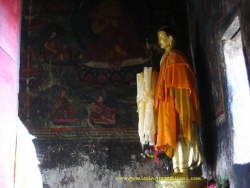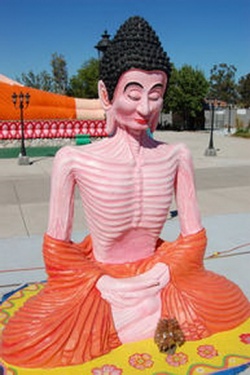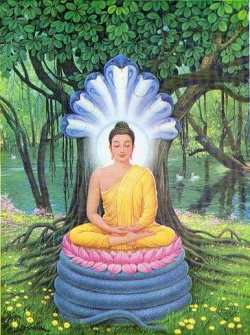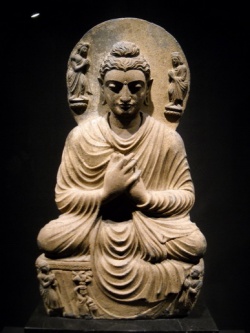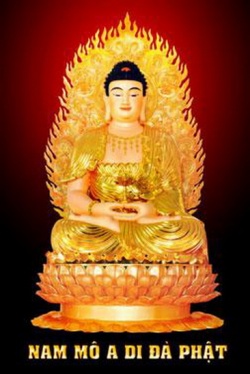Buddhaghoṣa
(Sanskrit; Pāli, Buddhaghosa). A monk, born at the beginning of the 5th century and considered to be the greatest of commentators on the Pāli Canon. The hagiographic accounts of his life report that because his speech, like that of the Buddha, was profound and his words spread throughout the world he came to be called Buddhaghoṣa, literally meaning ‘Buddha utterance’. Later tradition ascribes to him an exaggerated number of texts. It is said that while living in India he composed the Ñāṇodaya and the Atthasālinī, and also began to write a concise commentary (Parittaṭṭhakathā) on the Tripiṭaka (Pāli, Tipiṭaka).
Buddhaghosa Thera
The greatest of Commentators on the Tipitaka. He was a Brahmin. The Sās. (p. 29) says his father was a purohita, named Kesa, his mother being Kesī. Gv.66 says his father was the purohita of King Sangāma. He was born in a village near Buddhagayā and became proficient in the Vedas and allied branches of knowledge. One day he met a monk, named Revata, and on being defeated by him in controversy, entered the Order to learn the Buddha's teachings. Because his speech was profound, like that of the Buddha, and because his words spread throughout the world (like those of the Buddha), he came to be called Buddhaghosa. While dwelling with Revata, he wrote the Ñānodaya and the Atthasālinī, and also began to write a Parittatthakathā (a concise commentary) on the Tipitakas. In order to complete his task, he came over to Ceylon at the suggestion of Revata (Sās.p.29, says he was sent to Ceylon as punishment for thinking himself wiser than his teachers) and studied the Singhalese Commentaries at the Mahāvihāra, under Sanghapāla. When his studies were ended he wrote the Visuddhimagga, and having thereby won the approval of the Elders of the Mahāvihāra, he rendered the Singhalese Commentaries into Pāli. During this period he lived in the Ganthākaravihāra, and on the accomplishment of his task he returned to Jambudīpa. (Burmese tradition says he obtained his copy of the Tipitaka and the Commentaries from the Āloka vihāra. But see P.L.C.83, n.1.4).
Besides the above mentioned works of Buddhaghosa, we have also the Samantapāsādikā and the Kankhāvitaranī on the Vinaya Pitaka; the Sumangalavilāsinī, the Papañcasūdanī, the Sāratthappakāsinī and the Manorathapūranī on the Sutta Pitaka. He is also said to have compiled Commentaries on the Khuddakapātha and the Sutta Nipāta (called the Paramatthajotikā) and on the Dhammapada. He also wrote a series of Commentaries on the Abhidhamma Pitaka (the Atthasālinī, the Sammohavinodanī and the Pañcappakaranatthakathā). Some ascribe to him the Jātakatthakathā. For further particulars relating to Buddhaghosa, see Law's "Life and work of Buddhaghosa" and P.L.C.79 ff. The account of his life given here is taken from Cv.xxxvii.215ff . For a list of works ascribed to Buddhaghosa see Gv., pp.59 and 68.
2. Buddhaghosa. Called Culla Buddhaghosa to distinguish him from the greater. He was a native of Ceylon (Gv.67), and two works are ascribed to him (Gv.63) - the Jātattagīnidāna and the Sotattagīnidāna. The former probably refers to the Jātakatthakathā (P.L.C.126). It was at his request that Buddhaghosa (1) wrote his Commentaries to the Abhidhamma. Gv.68.
In order to complete his task, he went to Sri Lanka and studied the Sinhalese commentaries at the Mahāvihāra. When his studies ended he wrote the Visuddhimagga, and having won the approval of the monks of the Mahāvihāra, he rendered the Sinhalese commentaries into Pāli. According to the Theravādin tradition the commentaries came to Sri Lanka with the first Buddhist missionaries in the 3rd century bce. When this task was accomplished, Buddhaghoṣa returned to India. Besides the above-mentioned works Buddhaghoṣa is credited with composing the Samantapāsādikā and the Kaṇkhāvitaraṇī commentaries on the Vinaya Piṭaka, and the Manorathapūraṇī commentary on the Sūtra Piṭaka.
He is also said to have compiled commentaries on the Khuddakapāṭha, the Sutta Nipāta and on the Dhammapada. Some also ascribe to him the commentary on the Jātakas (Jātakaṭṭhakathā). In fact the Vinaya commentary is probably not his work, and the author of the Abhidhamma commentary states that he is writing it at the request of Buddhaghoṣa. It is probably safest to attribute to Buddhaghoṣa only the Visuddhimagga and the commentaries on the four Nikāyas or āgamas. The rest is best viewed as the work of the ‘school of Buddhaghoṣa’. Whatever their exact provenance, these works have exerted a major influence upon the doctrine of the Theravāda orthodoxy in Sri Lanka, and the teachings of Theravāda Buddhism as we know them today.
He is generally recognized by both Western scholars and Theravadins as the most important commentator of the Theravada.
Biography
Limited reliable information is available about the life of Buddhaghosa. Three primary sources of information exist: short prologues and epilogues attached to Buddhaghosa's works; details of his life recorded in the Mahavamsa, a Sri Lankan chronicle; and a later biographical work called the Buddhaghosuppatti. A few other sources discuss the life of Buddhaghosa, but do not appear to add any reliable material. His name means "Reverend Teacher" (Bhadanta+ācariya) and "Voice of the Buddha" (Buddha+ghosa) in Pali.
The biographical excerpts attached to works attributed to Buddhaghosa reveal relatively few details of his life, but were presumably added at the time of his actual composition. Largely identical in form, these short excerpts describe Buddhaghosa as having come to Sri Lanka from India, and settled in Anuradhapura.Besides this information, they provide only short lists of teachers, supporters, and associates of Buddhaghosa, whose names are not generally to be found elsewhere for comparison.
The Mahavamsa records that Buddhaghosa was born into a Brahmin family in the kingdom of Magadhi. He is said to have been born near Bodh Gaya, and to have been a master of the Vedas, traveling through India engaging in philosophical debates. Only upon encountering a Buddhist monk named Revata was Buddhaghosa bested in debate, first being defeated in a dispute over the meaning of a Vedic doctrine, and then being confounded by the presentation of a teaching from the Abhidhamma. Impressed, Buddhaghosa became a Buddhist monk and undertook the study of the Tipitaka and its commentaries. On finding a text for which the commentary had been lost in India, Buddhaghosa determined to travel to Sri Lanka to study a Sinhalese commentary that was believed to have been preserved.
In Sri Lanka, Buddhaghosa began to study what was apparently a very large volume of commentarial texts that had been assembled and preserved by the monks of the Mahavihara. Buddhaghosa sought permission to synthesize the assembled Sinhalese-language commentaries into a comprehensive single commentary composed in the Pali language. The elder monks sought to first test Buddhaghosa's knowledge, by assigning him the task of elaborating the doctrine regarding two verses of the suttas; Buddhaghosa replied by composing the Visuddhimagga. His abilities were further tested when deities intervened and hid the text of his book, twice forcing him to recreate it from scratch. When the three texts were found to completely summarize all of the Tripitaka and match in every respect, the monks acceded to his request and provided Buddhaghosa with the full body of their commentaries.
Buddhaghosa went on to write commentaries on most of the other major books of the Pali Canon, with his works becoming the definitive Theravadin interpretation of the scriptures. Having synthesized or translated the whole of the Sinhalese commentary preserved at the Mahavihara, Buddhaghosa reportedly returned to India, making a pilgrimage to Bodh Gaya to pay his respects to the bodhi tree.
The details of the Mahavamsa account cannot readily be verified; while it is generally regarded by Western scholars as having been embellished with legendary events (such as the hiding of Buddhaghosa's text by the gods), in the absence of contradictory evidence it is assumed to be generally accurate. While the Mahavamsa claims that Buddhaghosa was born in northern India near Bodh Gaya, the epilogues to his commentaries make reference to only one location in India as being a place of at least temporary residence: Kanci in southern India. Some scholars thus conclude (among them Oskar von Hinüber and A. P. Buddhadatta) that Buddhaghosa was actually born in southern India, and was relocated in later biographies to give him closer ties to the region of the Buddha.
The Buddhaghosuppatti, a later biographical text, is generally regarded by Western scholars as being legend rather than history. It adds to the Mahavamsa tale certain details, such as the identity of Buddhaghosa's parents and his village, as well as several dramatic episodes, such as the conversion of Buddhaghosa's father and Buddhaghosa's role in deciding a legal case. It also explains the eventual loss of the Sinhalese originals that Buddhaghosa worked from in creating his Pali commentaries by claiming that Buddhaghosa collected and burnt the original manuscripts once his work was completed.
Writings and translations
Buddhaghosa was reputedly responsible for an extensive project of synthesizing and translating a large body of Sinhala commentaries on the Pāli Canon. His Visuddhimagga (Pāli: Path of Purification) is a comprehensive manual of Theravada Buddhism that is still read and studied today. The Mahavamsa ascribes a great many books to Buddhaghosa's composition, some of which are not believed to have been his work, but rather were composed later and attributed to him.
Below is a listing of the fourteen commentaries traditionally ascribed to Buddhaghosa (Pāli: atthakatha) on the Pāli Tipitaka:
While traditional accounts list Buddhaghosa as the author of all of these works, the current consensus among scholars accepts only the Visuddhimagga and the commentaries on the first four nikayas as Buddhaghosa's work.
Influence and Legacy
In the 12th century, the Sri Lankan monk Sariputta became the leading scholar of the Theravada following the reunification of the Sri Lankan monastic community by King Parakramabahu I. Sariputta incorporated many of the works of Buddhaghosa into his own interpretations. In subsequent years, many monks from Theravada traditions in Southeast Asia sought ordination or re-ordination in Sri Lanka because of the reputation of the Sri Lankan Mahavihara lineage for doctrinal purity and scholarship. The result was the spread of the teachings of the Mahavihara tradition — and thus Buddhaghosa — throughout the Theravada world. Buddhaghosa's commentaries thereby became the standard method by which the Theravada scriptures were understood, establishing Buddhaghosa as the definitive interpreter of Theravada doctrine.
In later years, Buddhaghosa's fame and influence inspired various accolades. His life story was recorded, in an expanded and likely exaggerated form, in a Pali chronicle known as the Buddhaghosuppatti, or "The Development of the Career of Buddhaghosa". Despite the general belief that he was Indian by birth, he later may have been claimed by the Mon people of Burma as an attempt to assert primacy over Sri Lanka in the development of Theravada tradition. Other scholars believe that the Mon records refer to another figure, but whose name and personal history are much in the mold of the Indian Buddhaghosa.
Finally, Buddhaghosa's works likely played a significant role in the revival and preservation of the Pali language as the scriptural language of the Theravada, and as a lingua franca in the exchange of ideas, texts, and scholars between Sri Lanka and the Theravada countries of mainland Southeast Asia. The development of new analyses of Theravada doctrine, both in Pali and Sinhalese, seems to have dried up prior to Buddhaghosa's emergence in Sri Lanka. In India, new schools of Buddhist philosophy (such as the Mahayana) were emerging, many of them making use of classical Sanskrit both as a scriptural language and as a language of philosophical discourse. The monks of the Mahavihara may have attempted to counter the growth of such schools by re-emphasizing the study and composition in Pali, along with the study of previously disused secondary sources that may have vanished in India, as evidenced by the Mahavamsa. Early indications of this resurgence in the use of Pali as a literary language may be visible in the composition of the Dipavamsa and the Vimuttimagga, both dating to shortly before Buddhaghosa's arrival in Sri Lanka. The addition of Buddhaghosa's works — which combined the pedigree of the oldest Sinhalese commentaries with the use of Pali, a language shared by all of the Theravada learning centers of the time — provided a significant boost to the revitalization of the Pali language and the Theravada intellectual tradition, possibly aiding the Theravada school in surviving the challenge to its position posed by emerging Buddhist schools of mainland India.
Some scholars have argued that Buddhaghosa's writing evinces a strong but unacknowledged Yogācāra Buddhist influence, which subsequently came to characterize Theravada thought in the wake of his profound influence on the Theravada tradition.
Critics
The Visuddhimagga reflects changes in interpretation which appeared during the centuries since the Buddha's time.
The Australian Buddhist monastic Shravasti Dhammika is critical of contemporary practice. He concludes that Buddhaghosa did not believe that following the practice set forth in the Visuddhimagga will really lead him to Nirvana, basing himself on the postscript to the Visuddhimagga:
Even Buddhaghosa did not really believe that Theravada practice could lead to Nirvana. His Visuddhimagga is supposed to be a detailed, step by step guide to enlightenment. And yet in the postscript [...] he says he hopes that the merit he has earned by writing the Vishuddhimagga will allow him to be reborn in heaven, abide there until Metteyya (Maitreya) appears, hear his teaching and then attain enlightenment.
Yet Nanamoli notes that this postscript does not appear in the original Pali.
According to Kalupahanan, Buddhaghosa was influenced by Mahayana-thought, which were subtly mixed with Theravada orthodoxy to introduce new ideas. Eventually this led to the flowering of metaphysical tendencies, in contrast to the original stress on anatman in early Buddhism
(Sanskrit; Pāli, Buddhaghosa). A monk, born at the beginning of the 5th century and considered to be the greatest of commentators on the Pāli Canon. The hagiographic accounts of his life report that because his speech, like that of the Buddha, was profound and his words spread throughout the world he came to be called Buddhaghoṣa, literally meaning ‘Buddha utterance’. Later tradition ascribes to him an exaggerated number of texts. It is said that while living in India he composed the Ñāṇodaya and the Atthasālinī, and also began to write a concise commentary (Parittaṭṭhakathā) on the Tripiṭaka (Pāli, Tipiṭaka).
In order to complete his task, he went to Sri Lanka and studied the Sinhalese commentaries at the Mahāvihāra. When his studies ended he wrote the Visuddhimagga, and having won the approval of the monks of the Mahāvihāra, he rendered the Sinhalese commentaries into Pāli. According to the Theravādin tradition the commentaries came to Sri Lanka with the first Buddhist missionaries in the 3rd century bce. When this task was accomplished, Buddhaghoṣa returned to India. Besides the above-mentioned works Buddhaghoṣa is credited with composing the Samantapāsādikā and the Kaṇkhāvitaraṇī commentaries on the Vinaya Piṭaka, and the Manorathapūraṇī commentary on the Sūtra Piṭaka. He is also said to have compiled commentaries on the Khuddakapāṭha, the Sutta Nipāta and on the Dhammapada. Some also ascribe to him the commentary on the Jātakas (Jātakaṭṭhakathā).
In fact the Vinaya commentary is probably not his work, and the author of the Abhidhamma commentary states that he is writing it at the request of Buddhaghoṣa. It is probably safest to attribute to Buddhaghoṣa only the Visuddhimagga and the commentaries on the four Nikāyas or āgamas. The rest is best viewed as the work of the ‘school of Buddhaghoṣa’. Whatever their exact provenance, these works have exerted a major influence upon the doctrine of the Theravāda orthodoxy in Sri Lanka, and the teachings of Theravāda Buddhism as we know them today.

